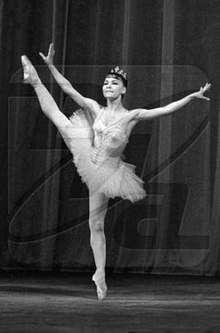Malika Sobirova
Malika Sobirova (Russian: Малика Сабирова, May 1942 — 27 February 1982) was a Soviet Tajik ballet dancer.[1] She is considered the most famous Tajik ballet dancer. In 1969, she won a gold medal in an international ballet dance competition.[2][3]
Malika Sobirova | |
|---|---|
 | |
| Born | May 1942 |
| Died | 27 February 1982 |
| Occupation | Ballet dancer, actor |
Early life
Sobirova was born in 1942 in Dushanbe, the capital of Tajikistan. Her father Ibragim Sabiroo was a musician and her mother Madina Sabirova was a nurse. As a young girl of 8 she was very stubborn and refused to be cowed down to a marriage as per the then prevalent practice, but she pursued her talent in dance.[4] She took her dancing course from Leningrad Choreography Academy, the Vaganova Ballet School, from where she graduated in 1961.[1][5][6] It was a tradition among the students of this ballet school to consider themselves incomplete till they performed the Swan dance. She was also keen to learn the complete music of the ballet.[6]
Career
In 1961, after graduating she returned to Dushanbe and joined Onegin Theatre.[7] She also joined People's Artist of the USSR and regularly performed at Tchaikovsky Hall.[8] She was proficient in all classical forms of ballet and won several international awards. As a solo ballet dancer her repertoire included all the classical forms, and performed in ballets like the Leili i Medzhnun (Leili and Medjnun) for which music score was provided by Balasan-ian. She was a popular ballet dancer in the Soviet Union.[3][9] She was the most popular dancer of the Opera and Ballet theater which was established in 1940.[10] She was delighted like a child when people recognized her in the bus or total strangers greeted her as a ballerina.[11]
Awards
She received the first prize at the Tchaikovsky International Ballet Contest in Moscow.[12] In 1969, Sobirova won a gold medal in an international ballet dance competition held in Varna, Bulgaria.[9] She was also recipient of Tadzhik Komsomol Central Committee order "The Badge of Honor."[13] The first international ballet dancing contest held in Dushanbe was named after her and President Gorbachev sent greetings on the occasion.[14]
References
- Koegler, Horst (1998). Dizionario della danza e del balletto. Gremese Editore. pp. 415–. ISBN 978-88-7742-262-0.
- Abdullaev, Kamoludin; Akbarzaheh, Shahram (27 April 2010). Historical Dictionary of Tajikistan. Scarecrow Press. pp. 262–. ISBN 978-0-8108-7379-7.
- Demidov, Alexander; Daniels, Guy (1978). The Russian ballet: past and present. A. and C. Black. p. 23. ISBN 978-0-7136-1874-7.
- William M. Mandel (1975). Soviet women. Anchor Books. p. 183. ISBN 978-0-385-03255-1.
- Peknik, George (1 January 2004). The Meaning of the Boulder-Dushanbe Teahouse. Hoopoe Press. p. 96. ISBN 978-0-9632591-1-0.
- Soviet Literature. Foreign Languages Publishing House. January 1981. p. 184.
- Dance and Dancers. 1980.
- Khrushchev, Nikita Sergeevich; Khrushchev, Sergey (2006). Memoirs of Nikita Khrushchev. Penn State Press. pp. 750–. ISBN 0-271-02861-0.
- Sputnik Monthly Digest. Novosti Printing House. 1974. pp. 64, 66.
- Agentstvo pechati "Novosti" (1990). USSR. Novosti Press Agency.
- Soviet Life. Embassy of the Union of the Soviet Socialist Republics in the USA. 1976.
- A. Tatulov (1974). USSR, cultural life. Novosti Press Agency Pub. House. p. 48.
- Foreign Press Digest: Soviet Union. October 1967.
- Daily Report: Soviet Union. The Service. 1991. p. 31.